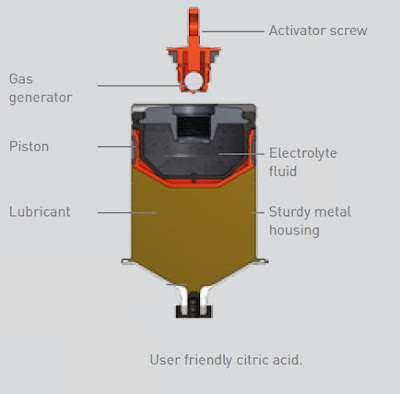The basic role of a lubricator is to drive oil or grease into
the lubrication point, ensuring the smooth operation and prolonged life of
machinery, minimal wear and tear, and avoid downtime. Inexpensive and simple
to fit, Single-point lubricator take seconds to install while bringing a wide
array of benefits:
- Maximize efficiency
- Save hundreds of maintenance hours
- Increase up-time
- Boost reliability and safety
- Eliminate human error
- Move away from scheduled maintenance
- Provide continuously, uninterrupted lubrication to the individual, expensive components
Types of Automatic Single Point Lubricators
- Gas-powered Lubricator
- Electro-chemical Lubricator
- Electro-mechanical Lubricator
*Gas-powered Lubricator :
The gas-powered units are actuated by mixing
an electrolyte and zinc pellet to form a gas. The gas expands against a plunger
that pushes the grease out of the unit at 45 PSI. They have a 3-6-9-12 month
dispensing range that requires a different concentration of zinc. However, they
are temperature-dependent.
That is, when
it is 0° they will push harder for less grease; whereas, when it is 90° they
will work less to lube the bearing. Some of the canisters are made of metal so
you will not know if the unit is operating properly or injecting the grease.
These cost the least out of the 3 and are a throw-away.
*Electro-chemical Lubricator
Electrochemical
units use a battery, microprocessor and an electrolyte to create a gas that
pushes the grease. The processor tells the battery to excite the electrolyte to
create a gas. The processor compensates for low temperature.
When it is
10° the processor senses it and adjusts the unit accordingly. The unit
dispenses the same amount of lubrication no matter what the outside temperature
is. Some units have dip switches or jumpers that can be set for each of the
different month settings. These units can be paused or turned off if the
equipment is going to be out serviced for a while.
*Electro-mechanical Lubricator
All
electromechanical lubricators have a battery, pressure source, programmable
controller (LED). And grease pack. The
LED controls a motor that pushes the grease. The type of motor dictates the
amount of pressure the unit is capable of. This is important depending on how
far the bearing tap is from the unit.
They have
replaceable batteries and grease packs so purchasing the complete unit are not
necessary, making it economical after the initial purchase is made. The most important feature is the feedback if the bearing does not accept the
lubrication which separates it from the other two types of lubricators.
If the
bearing or lube line is clogged and the unit can not push the grease, a fault
occurs. There will be a flashing indication on the LED. This is very important
for critical bearing. If and when this occurs some units have a memory that can
be checked to see when the last lube event took place.
The units
that can produce a pressure of 400 PSI plus can do multiple bearings using a
divider valve. They can do 1 to 8 bearings because they lube only one bearing
at a time. Keeping in mind the shorter the lube lines the better.






![What Is [ Lubrication ] ?](https://blogger.googleusercontent.com/img/b/R29vZ2xl/AVvXsEgET6e2kj8GQcaAjy9r__Vrl2Bj4gc1j0dF7ASnrKCW6NA4d02Nk-Cljmkepa9XSydD_SiKP0p-qMkMAIZGAC5FFZIoOxOLa_Yx9WDCc1G63Qk6Yt5CU6YU8lLzKZ_7fHhfeuSECXy7kdq9/w680/What+is+Lubrications.jpg)



0 Comments